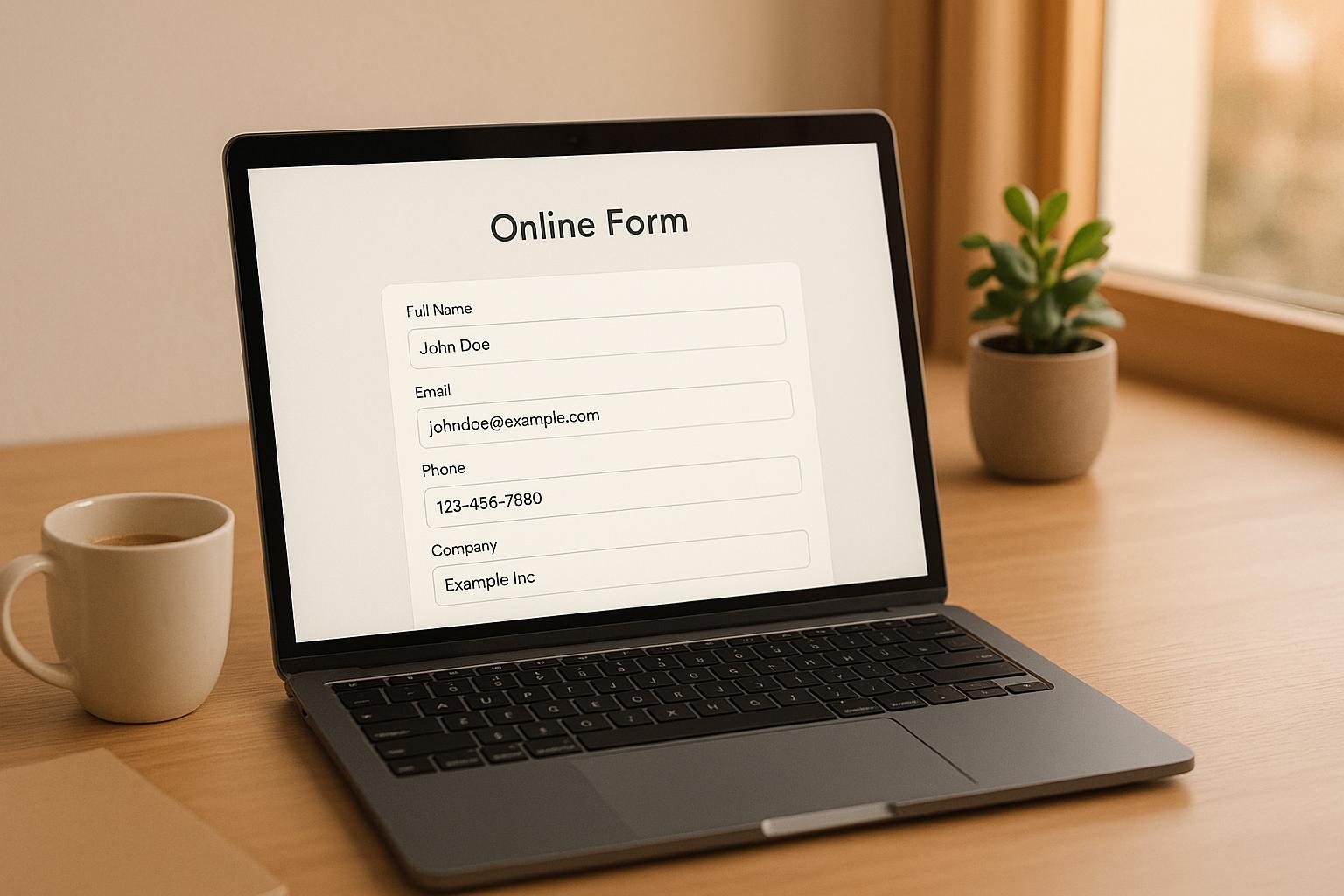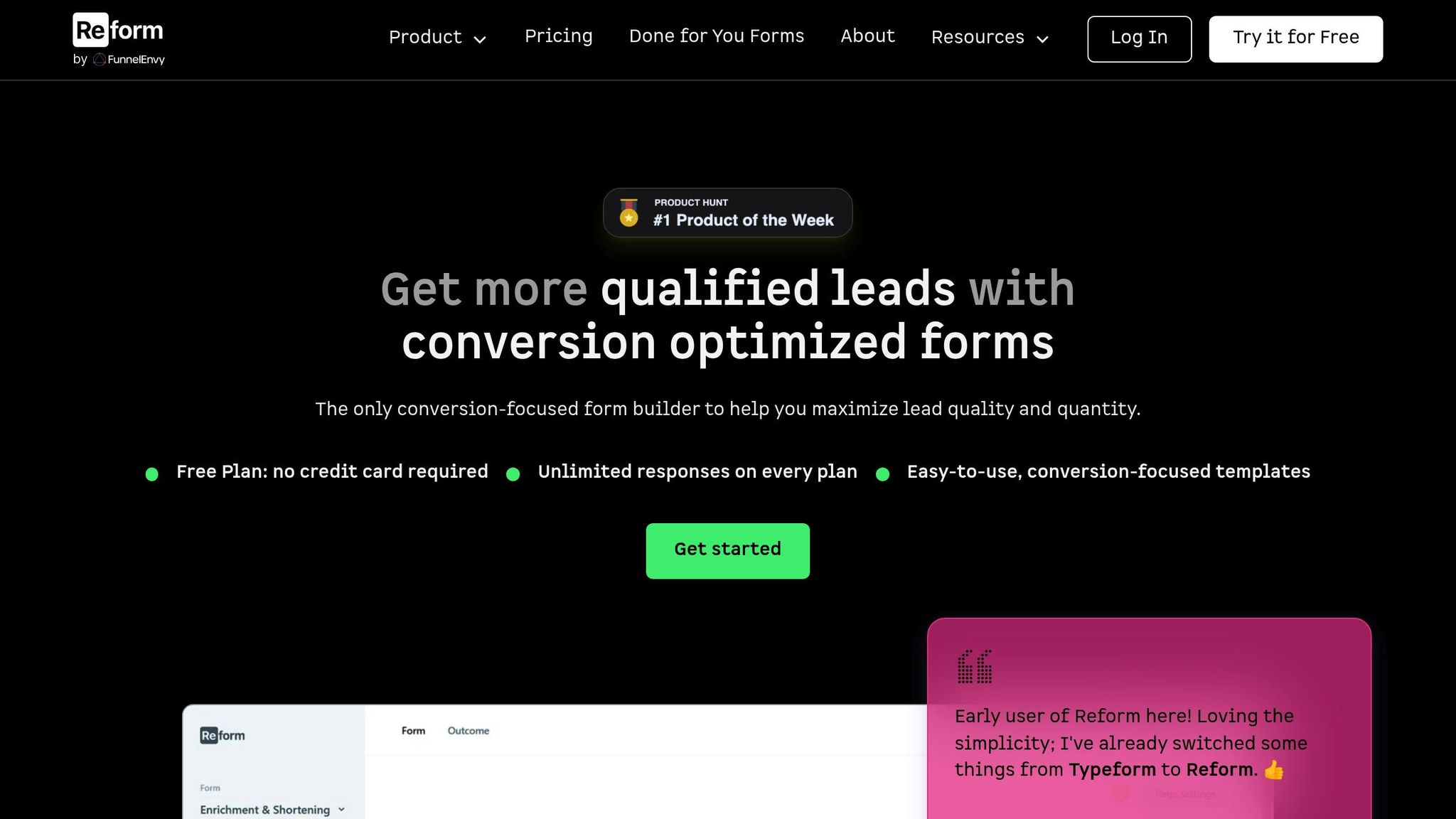How to Use Pre-Filled Fields for Better Conversions

Pre-filled fields simplify online forms by automatically filling in user details like name, email, or company. This reduces friction, speeds up completion, and boosts conversions - up to 215% more qualified leads for businesses. By pulling data from CRMs, cookies, or URL parameters, users save time and avoid repetitive input.
Key takeaways:
- Improved user experience: Less manual entry means fewer errors and lower form abandonment rates.
- Faster completion: Especially helpful for mobile users.
- Accurate data: Verified sources ensure cleaner, usable information.
To implement, focus on fields like contact details, connect reliable data sources, and ensure compliance with privacy laws like GDPR. Use tools like Reform to track performance, A/B test strategies, and refine forms based on analytics. Simple, transparent, and user-friendly forms lead to higher conversions and better engagement.
How to increase conversion using form prefill
Key Benefits of Using Pre-Filled Fields
Pre-filled fields offer more than just convenience - they can reshape how users interact with your forms, improving both conversion rates and the quality of the data you collect.
Better User Experience
Nobody enjoys repetitive data entry. By auto-filling forms with known information, you make the process smoother and more intuitive. When users see their details already in place, it reduces the effort required and makes the experience feel seamless.
This small adjustment can have a big impact. Returning users are more likely to complete forms when their time is respected with pre-filled details. This not only lowers form abandonment rates but also ensures a smoother, error-free process, making it easier to collect accurate information.
More Accurate Data
Manual entry is prone to mistakes, especially when users are in a hurry or navigating forms on mobile devices. Pre-filled fields solve this problem by pulling verified data from trusted sources like CRMs, previous submissions, or authenticated accounts.
The result? Cleaner, more reliable data. This reduces the time your team spends fixing errors and allows them to focus on engaging with qualified leads. Accurate data also ensures smoother integration with marketing and sales systems, improving overall efficiency.
Faster Completion Times
Speed matters when it comes to form completion. The longer it takes to fill out a form, the greater the chance users will abandon it. Pre-filled fields cut down on time by eliminating the need for users to re-enter information. Instead, they simply verify details like names, emails, or job titles.
This is especially important for mobile users, where typing can be cumbersome. By reducing friction, pre-filled fields make the process faster and more user-friendly, directly boosting conversion rates and ensuring more successful submissions.
With Reform's form builder, implementing pre-filled fields is straightforward. Its built-in capabilities work effortlessly across devices, and real-time analytics let you measure the impact on completion rates and conversions. It’s a simple way to create a better experience for users while driving better results for your business.
How to Set Up Pre-Filled Fields
Setting up auto-filled fields can make your forms more user-friendly, but it’s important to plan carefully. The process involves choosing the right fields to pre-fill, connecting reliable data sources, and ensuring you’re following privacy laws. Here’s how you can get started.
Choose Which Fields to Pre-Fill
Start by identifying the fields that will have the biggest impact on improving conversions. Common choices include name and email address since these are often stored in browsers or collected during previous interactions. Plus, users generally find typing these repeatedly a hassle.
For B2B forms, contact details like phone numbers and company names are useful, especially when dealing with returning visitors or leads who’ve already engaged with your content. If your business relies on location-specific services or shipping, location data can also be helpful.
However, avoid auto-populating sensitive fields like credit card numbers or social security numbers. Most users prefer entering this type of information manually for security reasons. Similarly, fields that require personal opinions, such as survey responses, should remain manual to avoid skewing results.
Think about your form’s purpose when deciding which fields to pre-fill. For example, a simple newsletter signup form might only need an email address, while a demo request form could benefit from pre-filled fields like name, email, company, and job title. The goal is to make the process easier without disrupting the natural flow of the user experience.
Once you’ve chosen your fields, the next step is connecting the right data sources to fill them automatically.
Use Data Sources for Pre-Filled Fields
Here are some common ways to pull data for pre-filled fields:
- CRM integration: Pull contact information directly from your CRM to streamline the process for returning users.
- Browser cookies and local storage: Use browser cookies or local storage to recall previously submitted data, especially for multi-step forms.
- URL parameters: Add URL parameters to email campaigns to pre-fill forms for event signups or specific landing pages.
- Third-party data enrichment services: Automatically add details like job title, company size, or industry based on an email address or domain. This reduces the number of questions you need to ask directly.
Reform’s platform simplifies this process with built-in integrations. It can pull data from your CRM, use browser-stored information, and handle URL parameters - all without requiring complicated technical setups.
Follow Privacy and Compliance Rules
After setting up your fields and data sources, make sure your system complies with privacy regulations like GDPR and CCPA.
You’ll need to get explicit consent from users, include clear opt-in language, and provide opt-out options for non-essential data. Transparency is key - always let users see what information has been pre-filled and give them the ability to update or clear it. This is especially important for shared devices or if a user’s details have changed.
Data accuracy is another critical factor. Outdated or incorrect pre-filled data isn’t just a poor user experience - it can also lead to compliance issues. Regularly clean your data and allow users to update their information as needed.
For added compliance, implement audit trails to track how data is used and stored. Many privacy laws require you to show how you’re protecting user information. You can also integrate consent management tools to give users more control over what data is used for pre-filling. For example, let them choose to pre-fill contact details but not demographic information, so they can decide how much convenience they want.
sbb-itb-5f36581
Best Practices for Pre-Filled Forms
Creating effective pre-filled forms goes beyond just setting up the technical aspects. The way these forms are designed and implemented can make or break the user experience. When done right, they simplify the process, build trust, and boost conversion rates. Here's how to nail it.
Keep Forms Short and Simple
When it comes to forms, less is definitely more. Even with pre-filled fields, every extra field increases the chances of users abandoning the form. Stick to asking for only the information you need at that moment.
A single-column layout works best. It provides a clear, straightforward path for users to follow. On the other hand, scattered or multi-column designs can confuse users, especially on mobile devices where space is limited. Keep it clean and predictable.
For longer forms, try breaking them into steps using a progressive disclosure approach. Show only the most relevant fields first, and reveal more as users progress or based on pre-filled data. This keeps things manageable and less overwhelming.
Visual hierarchy plays a big role, too. Make sure pre-filled fields stand out subtly - like using a light background color or a border - so users can quickly identify which sections are already completed. This keeps the flow smooth without distracting from the overall design.
Once your layout is optimized, focus on smart defaults and error prevention to further refine the experience.
Use Smart Defaults and Real-Time Validation
Smart defaults and validation can make filling out forms even easier. Pre-filling fields with intelligent defaults - like contact details or options based on user behavior - can save time and reduce friction. For example, if a visitor is exploring business solutions, pre-selecting a relevant tier can simplify their decision-making.
Using conditional logic for pre-filling fields adds a layer of personalization. For instance, if an email domain suggests the user works for a large company, you might pre-fill the "Company Size" field with "1,000+ employees." Just make sure the field remains editable so users can correct it if needed.
Real-time validation is another key feature. As users move through the form, validate critical inputs like email addresses or phone numbers to catch errors early. This not only ensures accuracy but also gives users confidence in the process.
Always allow users to edit pre-filled fields. While some fields may need to be read-only, giving users the option to update their information usually improves both trust and accuracy. And when errors do occur, provide clear, helpful messages that explain what went wrong and how to fix it.
Be Transparent and Accessible
Trust and accessibility are just as important as design and functionality. Transparency helps users feel more comfortable when they see pre-filled data. Clearly indicate where the information came from - such as a previous visit or an email domain - so users understand why certain fields are already completed.
Respecting privacy is non-negotiable. Make your privacy policy easy to find and include a brief explanation of how pre-filled data is used. This reassures users that their information is handled responsibly and in line with regulations.
Accessibility matters, too. Ensure that screen readers can properly announce pre-filled values and that users can navigate forms easily with a keyboard. Clear labels and helpful placeholder text further enhance usability, making it easier for everyone to understand each field.
For added flexibility, include an option to "Clear all pre-filled data." This is especially useful for users on shared devices who may prefer entering their information manually.
Finally, prioritize mobile optimization. Ensure touch targets are large enough, and the form adapts well to different screen sizes and orientations. Well-designed pre-filled forms can significantly improve mobile conversion rates by minimizing typing and streamlining the process.
Measuring and Improving Performance
Tracking performance is the key to turning functional forms into tools that drive better conversions. Pre-filled fields are designed to enhance user experience and reduce friction, but their effectiveness hinges on proper measurement. A structured approach to tracking, testing, and refining forms ensures you can make data-driven improvements.
Track Conversion Metrics
Keeping an eye on your form completion rate is crucial - it tells you how many users finish the form after starting it. Pay attention to friction points like confusing or incorrectly filled fields, as these can highlight areas needing improvement.
Another metric to watch is the time it takes users to complete the form. Pre-filled fields should ideally speed up the process. If users aren't completing forms faster, they might be spending extra time double-checking or fixing the pre-filled information.
Also, monitor how often users edit pre-filled entries. A high rate of corrections might point to unreliable data sources or errors in the pre-filling logic. To assess the quality of leads, compare how well pre-filled form submissions perform in your sales funnel versus manually completed ones.
A/B Test Pre-Filled Field Methods
Experimenting with different pre-filled field strategies can help you figure out what works best for your audience. Start by comparing pre-filled forms to standard ones to measure any conversion rate improvements.
You can also test various data sources for pre-filling. For example, try automatically filling in company details based on email domains and compare it to manually entered data. Determine which fields benefit most from pre-filling and evaluate whether pre-filling too many fields might make users skeptical.
Styling choices for pre-filled fields also matter. Test subtle background highlights or placeholder text to see how these design elements influence trust and completion rates. Additionally, consider adding messaging that explains where the pre-filled data comes from - this transparency might boost user confidence.
Make sure your tests run long enough to gather meaningful data. The insights you gain will guide your next steps in optimizing the form.
Use Reform's Real-Time Analytics

Reform's analytics dashboard gives you instant insights into how your pre-filled forms are performing. With real-time tracking, you can pinpoint where users drop off and address those issues quickly.
The abandoned submission tracking feature highlights incomplete forms, helping you identify which fields might be causing users to hesitate. Field-level analytics show how often pre-filled fields are edited and how much time users spend on each section, providing clear direction for improvements.
Reform also offers a conversion funnel visualization, mapping the entire user journey from viewing the form to submission. This helps you determine whether pre-filled data is simplifying the process or causing users to spend extra time reviewing and editing.
Evaluate the accuracy of your data sources by tracking their performance. Reform integrates seamlessly with your CRM, allowing you to monitor how leads from pre-filled forms perform compared to others.
Finally, leverage Reform's A/B testing tools to experiment with different pre-filled form variations. The platform automatically splits traffic and tracks performance metrics, making it easy to test new strategies without complicated setups.
Conclusion and Key Takeaways
Pre-filled fields have the power to reshape how users interact with forms, making the process faster and more enjoyable. With up to 86% of users abandoning lengthy forms, integrating pre-filled fields can significantly improve conversion rates - by as much as 200%.
The key to success lies in thoughtful implementation. Focus on pre-filling fields that genuinely save users time, like contact details and addresses, while ensuring data accuracy and security remain priorities. Pairing pre-filled fields with features like smart defaults, real-time validation, and a clean, minimalist design can make the experience even smoother.
Testing is critical. Cross-browser testing ensures your pre-fill functionality works seamlessly on all platforms, minimizing errors in data population. If you're handling sensitive information, such as payment details, robust security measures are non-negotiable.
The best forms strike a balance between convenience and transparency. Users value the time saved but also want to know how their information is being used and to retain control over what gets submitted. Building trust through transparency can lead to higher-quality leads and stronger user relationships.
Reform simplifies pre-filled form implementation with built-in analytics and seamless integrations. Start small, test often, and let data drive your improvements. Pre-filled fields can transform casual visitors into engaged, qualified leads.
FAQs
How can businesses stay compliant with privacy laws when using pre-filled form fields?
To comply with privacy laws when using pre-filled form fields, businesses need to focus on protecting data. This means employing safeguards like encryption and limiting access to sensitive information. Keeping data secure should always be a top priority.
Equally important is obtaining explicit user consent before pre-filling any personal details. Users should clearly understand how their information will be used and stored, leaving no room for ambiguity.
It's also essential to adhere to regulations like HIPAA or GDPR. This includes practices such as collecting only the necessary data, giving users the ability to review or update pre-filled fields, and being transparent about how data is managed. These actions not only ensure compliance but also strengthen user confidence in your business.
What’s the best way to choose which fields to pre-fill for higher conversions?
To boost conversions, focus on pre-filling form fields that users find most familiar and straightforward, such as their name, email address, or phone number. These fields are easy for users to recognize and verify quickly.
Whenever you can, leverage data from past interactions or existing customer information to make the process smoother and more personalized. For instance, if a user has previously shared their contact details, pre-filling those fields can save them time and effort.
Concentrate on fields that are critical to your form’s purpose, like payment or delivery details, but ensure all pre-filled information is accurate and current. This approach not only enhances the overall user experience but also builds trust, encouraging users to complete the form and increasing engagement.
How can businesses evaluate the effectiveness of pre-filled fields in boosting form completions and conversions?
To see how well pre-filled fields work, businesses can look at form completion rates and conversion metrics before and after adding them. A smart way to measure their impact is through A/B testing, which compares different versions of a form to see how users respond.
On top of that, tools like real-time analytics and form tracking can shed light on how users interact with forms. These tools help spot any sticking points or areas that might need tweaking. By keeping an eye on these metrics over time, businesses can get a clear sense of how pre-filled fields are improving outcomes.
Related Blog Posts
Get new content delivered straight to your inbox

The Response
Updates on the Reform platform, insights on optimizing conversion rates, and tips to craft forms that convert.
Drive real results with form optimizations
Tested across hundreds of experiments, our strategies deliver a 215% lift in qualified leads for B2B and SaaS companies.





